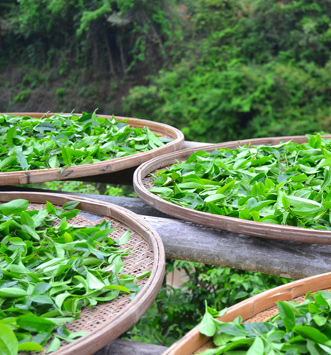
The world's oldest tea trees originate from Yunnan tea gardens in China. The large leaves of these trees, cultivated with respect for biodiversity, produce quality organic tea and sometimes in the original cake form. Rich in antioxidants, this Chinese tea offers numerous benefits.
Yunnan tea gardens in harmony with nature
As China's only tropical region, Yunnan enjoys spring-like climate throughout the year and an altitude conducive to organic tea production. Wild tea trees, pu-erh, and other black teas have made this region famous.
The origin of black tea production in Yunnan
Over 2,000 years ago, the historic city of Pu-erh, located on the Tea Horse Road between China and Tibet, was a trading hub. Pu-erh, a red/black tea, became the drink of nomads who traded it for other goods. For easier storage and transport, tea leaves were compressed into cakes.
The reputation of Pu-erh tea reached its peak under the Qing dynasty (1636-1912). The years 1926-1936 marked a period of great prosperity for tea production and sales.
Biodiversity in tea tree plantations
The ethnic groups in the region pay particular attention to nature's rhythm. Their organic farming practices influence the quality of their products.
Like wild tea gardens, large trees of various species provide natural protective shade. They are a refuge for birds, bees, or spiders that control pest invasions. They eliminate weeds and their dead leaves produce fertilizer. They also protect against erosion on sloping terrain.
Beverages and other products from the Yunnan tea tree
The application of traditional methods of cultivation, harvesting, and processing produces an organic tea with a unique taste. The picking is done directly from trees that are not cut into shrubs. Thanks to ideal conditions, harvesting takes place throughout the year.
The quality of organic black teas produced in Yunnan
The large leaves of Camellia Sinensis variety assamica from Yunnan are used to produce a particularly antioxidant-rich organic black tea. Their buds are rich in essential oils and give a copper color. They allow for the preparation of a deep and subtle black tea, sometimes with a hint of dried fruits.
The quality of the harvest and the size of the tea leaves determine the tea grades (for example, TGFOP for Tippy Golden Flowery Orange Pekoe). Added to the appellations "imperial garden" or "grand garden", they are often used in names created by each tea house in France.
Erh black tea or Yunnan pu-erh
Pu-erh is the most famous of the dark teas (red in Asia, black in the West). It comes from large dried leaves compressed into cake form (Tuo Cha) or bird's nest shape. Pu-erh is a green tea when raw, meaning without fermentation. Like green and natural teas, it is rather bitter. Black or cooked pu-erh comes from a more modern production. It is fermented in factories and intended for export.
Vegetable oil: a skincare product from the tea tree
The list of tea tree benefits extends to the vegetable oil of camellia sinensis, or green tea oil, obtained by cold pressing the tea plant flower seeds. Its nourishing and softening qualities are ideal in anti-aging cream and for protecting dry skin from external aggressions. It can be used pure or mixed with essential oils.
In France, organic tea figures show a growing market representing nearly 500 million euros. Two out of three French people drink tea (250g per year) and one in two drink herbal teas. French businesses are adapting, and tea trading turnover shows full growth in sales and distribution methods. Tea room and store franchises are showing strong growth. French consumers don't hesitate to pay a higher price for organic teas or herbal infusions. The cup of tea still has a bright future.